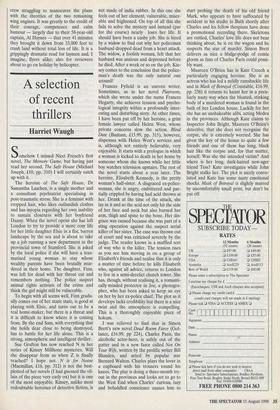Tumult in the clouds
Alan Judd
BLACK BOX: COCKPIT VOICE RECORDER ACCOUNTS OF IN- FLIGHT ACCIDENTS edited by Malcolm Macpherson HarperCollins, f8.99, pp. 184
COCKPIT: [Sound of a thump] CAPTAIN: What was that? CO-PILOT: I don't know.
Back in the cabin the rest of us, unknow- ing, tuck into our rubber chicken and plas- tic salads and reflect on the reassuring rarity of death in aircraft accidents. Some- times, however, trouble starts in the cabin and the first the crew know of it is the screaming from within as the passengers are fried at 3,000 degrees Fahrenheit in an oxy- gen fire of which the pilots are about to become all too briefly aware. This is what happened in the 1996 Florida Everglades crash when the aircraft, named Critter, plunged without trace into an alligator swamp.
For the Ancient Order of Ghouls that was, of course, one of the more memorable of modern air disasters, and it was con- sciousness of my own ghoulishness that made me slightly reluctant to review this book. I was not sure that we ghouls should, as it were, come out in such an obvious way. At Oxford I was once barred from a lecture on air-crash victims because I wasn't a medical student, since when I have learned to dissemble. The fact that the Mum, Dad, I'm expecting . . . a council house, family credit, housing benefit and income support!' book doesn't set out to be ghoulish, dresses up the subject responsibly and includes recordings from disasters thankfully avert- ed does not, however, mean that its public appeal isn't essentially macabre, as the lurid orange-and-black cover testifies. It may be that you have to be a touch ghoul- ish even to pick it up, but once you have, in guilty privacy, it's very hard to put down.
Not that the last words of the doomed are very remarkable. The pilots concerned are too busy wrestling with the inevitable for any posturings of the 'I think I am becoming a god', or 'Tell Mary I love her' or 'Please feed the cat' sort. They tend to say, 'More! More!' (height) or 'Oh no' or `Oh God'. It might be different for the pas- sengers, such as those of KAL 007, mur- dered by the Russian air force in 1983, who had to endure seven minutes between being hit by a missile at 35,000 feet and crashing. Decompression doubtless did for them first, of course, but even so they had to die to the irritating accompaniment of the public address system telling them end- lessly to put out their cigarettes.
Most of us, I suppose, would sit there in fearful numbness, thinking variations on the theme. of not me, not now and what a waste for it all to end thus. It could be worse, though: David Crane, the biogra- pher, found himself facing apparent death in a fit of vexation at his fellow men when a fire on board prompted the Japanese on one side of him to try to squeeze into the ashtray and the Dutchman on the other to drink loud farewells to all.
Those who fear flying will never be reassured by statistics, but, as Macpher- son's introduction shows, they should be. Almost anything is more dangerous than commercial flying, including eating, though it may be wise to except China Airlines. (What means "Pull up"?' asked a doomed Chinese pilot in response to the urgings of his ground-proximity warning system.) Nearly all the examples here are American, so it is perhaps appropriate to quote Amer- ican statistics: in 1993 only one person died in an aviation accident in the whole of America, and that was because he walked into a propeller blade, though the average is about 100 a year in commercial flying incidents. That compares with 19,000 who were murdered in 1996, 41,907 killed in car accidents and 714 while boating. But it's the planes that make the news.
As for the famous black box that records all this, it is actually two recording systems: the Flight Data Recorder (FDR), which records what the plane is doing, and the Cockpit Voice Recorder (CVR), which records what goes on in the cockpit. Both are sensibly lodged in the tail, which is the bit most likely to survive. For some reason I thought they were in the nose.
The most dramatic entry here, and the longest, is the 1989 DC10 crash at Sioux City, caused by an explosive failure of the tail engine which knocked out all steering and hydraulic mechanisms and left the crew struggling to manoeuvre the plane with the throttles of the two remaining wing engines. It was greatly to the credit of their courage, competence and calm humour — largely due to their 58-year-old captain, Al Haynes — that over 41 minutes they brought it down from 33,000 feet to crash land without total loss of life. It is a grippingly dramatic read for laymen and, I imagine, flyers alike; also for reviewers about to go on holiday by helicopter.



























































 Previous page
Previous page